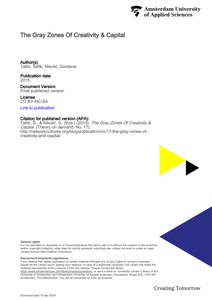About this publication: What is the correlation among the creative industries, creative industry policies, new media paradigms and capitalism as colonial relations of dominance? What is the role of these industries in the prioritization of the interests of capital at the expense of those of society and how can these paradigms be criticized in the context of the actual, neoliberal, flexible regime of reproduction of capital? To what measure is this regime ‘flexible’ and to what measure it is just an extension of rigid, feudal and racial logics that underline (post)modern representational discourses? To what measure do the concepts of creativity, transparency, openness and flexibility conceal the hegemonic nature of modern hierarchies of exploitation?This publication brings together six essays that offer a critique of the relationship between the creative industries and capital. It treats ‘the networked world’ — its democracies, cognitivities, its attention and its paradigmatic cultural discourses — as one of the domains wherein and by which capitalism and its colonial relations of dominance are being reproduced, reorganized, perpetuated and ‘modernized’.The Gray Zones of Creativity and Capital (eds. Gordana Nikolić and Šefik Tatlić) consists of works from a diverse range of authors from around the globe: Jonathan Beller, Josephine Berry Slater, Marc James Léger, Ana Vilenica, Sandi Abram & Irmgard Emmelheinz. The book first appeared in Serbian in 2015.
MULTIFILE

This article provides a study of precarisation through the lens of dress work: the mundane practice of dressing the body for work. Based on intimate in-depth wardrobe interviews and analyses of workers’ narratives about their dressing practices, we develop a perspective on what insecure work feels like for workers in the interactive services and creative industries. We understand dress work as a materially mediated practice in which workers often aim to achieve a level of comfort: a state in which they are allowed to become less reflexive about their bodies. One of the ways in which precarisation makes itself known, we contend, is through the temporal logic of the interruption. The temporality of zero-hours contracts and short-term, insecure labour interrupts the achievement of comfort as workers are not allowed the time to experience their work, colleagues and spaces. The discomfort and sometimes pain of insecurity of post-Fordist labour is thus felt on the body.
Een kunstenaar moet hedendaags zijn, wil hij serieus genomen worden. Maar waar komt die verheerlijking van het hedendaagse vandaan? Hoe relevant is hedendaagsheid in de kunst en het kunstonderwijs eigenlijk? Dit boek gaat vanuit diverse perspectieven dieper in op het thema hedendaagsheid. Wat maakt het hedendaagse nu zo belangrijk dat haar schijn een haast mythologiserend karakter krijgt?
MULTIFILE